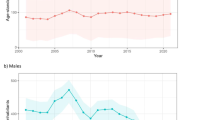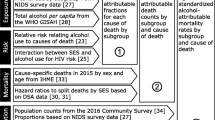Abstract
Measurement of alcohol use and associated harms at the city level is often incomplete or non-existent even though such data are often critical to informing local prevention strategies. This paper models how to generate local estimates of the morbidity, mortality, and cost of current alcohol use instead of abstaining. Administrative data sources, including medical examiner records, hospital records, and police records, among others, were used to obtain local estimates of alcohol-attributable outcomes. In 2018, we used alcohol-attributable fractions and scaled national estimates to quantify the burden of current alcohol use in Baltimore, MD, in 2013. Fifty-two percent of Baltimore adults reported past 30-day drinking. There were 276 alcohol-attributable deaths in 2013, and 106 (38.4%) of these were persons other than the drinker. In 2013, current alcohol use cost $582.3 million in Baltimore City. This burden was distributed across drinkers (40.1%), persons other than the drinker (21.3%), and the government (38.6%). It is possible to quantify this burden at the local level, and these data could be used to inform evidence-based alcohol policy strategies at the local level.



Similar content being viewed by others
References
Global Burden of Disease Study. Global burden of disease (GBD) results. Seattle, WA: Institution for Health Metrics and Evaluation; 2017. p. 2017.
Ashe M, Jernigan D, Kline R, Galaz R. Land use planning and the control of alcohol, tobacco, firearms, and fast food restaurants. Am J Public Health. 2003;93(9):1404–8.
World Health Organization. Global status report on alcohol and health 2018. Geneva, Switzerland: World Health Organization; 2018.
GBD (2016) Alcohol Collaborators. Alcohol use and burden for 195 countries and territories, 1990-2016: a systematic analysis for the Global Burden of Disease Study 2016. Lancet. Sep 22 2018;392(10152):1015-1035.
Sacks JJ, Gonzales KR, Bouchery EE, Tomedi LE, Brewer RD. 2010 national and state costs of excessive alcohol consumption. Am J Prev Med. 2015;49(5):e73–9.
Bouchery E, Simon C, Harwood H. Economic costs of excessive alcohol consumption in the United States, 2006. Atlanta, GA: Centers for Disease Control and Prevention; 2013.
Spencer M, Petteway RJ, Bacetti L, Barbot O. (2011) Healthy Baltimore 2015: a city where all residents realize their full health potential. Baltimore, MD: Baltimore City Health Department;.
Maryland Department of Health and Mental Hygiene. Drug and Alcohol-Related Emergency Department visits in Maryland 2008-2014. Baltimore, MD: Maryland Department of Health and Mental Hygiene; 2015.
Maryland Department of Health and Mental Hygiene (2012) Maryland violent death reporting system 2010 surveillance report. Baltimore, MD.
League of Oregon Cities, Association of Oregon Counties 2011. The financial impact of alcohol-related costs on cities and counties. Salem, OR.
Paileeklee S, Kanato M, Kaenmanee S, McGhee SM. Alcohol drinking behaviour and economic cost incurred by users in Khon Kaen. J Med Assoc Thail. Mar 2010;93(Suppl 3):S38–44.
Canadian Substance Use Costs and Harms Scientific Working Group. Canadian substance use costs and harms (2007–2014). Ottawa, Ontario: Prepared by the Canadian Institute for Substance Use Research and the Canadian Centre on Substance Use and Addiction; 2018.
Centers for Disease Control and Prevention. Behavioral Risk Factor Surveillance System overview: BRFSS 2013. Atlanta, GA; 2014.
Chapter 10.37.06 Submission for hospital discharge data set to the commission. In: Hygiene DoHM, ed. Title 10. Part 5. Subtitle 37. Chapter 10.37.06; 2016.
City of Baltimore. Open Baltimore; 2016.
Centers for Disease Control and Prevention. Alcohol-Related Disease Impact (ARDI) tool. Available at: https://nccd.cdc.gov/DPH_ARDI/Default/Default.aspx. Accessed 21 December 2016.
World Health Organization. International Classification of Diseases (ICD) Information Sheet. Available at: http://www.who.int/classifications/icd/factsheet/en/. Accessed 9 October 2018.
National Highway Traffic Safety Administration. Traffic safety facts: alcohol impaired driving. Washington, DC: US Department of Transportation National Highway Traffic Safety Administration; 2017.
May PA, Gossage JP. Estimating the prevalence of fetal alcohol syndrome: a summary. Alcohol Res Health. 2001;25(3):159–67.
Baltimore City Government. Ambulance Billing Information. Available at: http://www.baltimorecountymd.gov/Agencies/fire/ems/ambulancebilling.html. Accessed 12 December 2018.
Justice Policy Institute. The right investment? Corrections spending in Baltimore City. Baltimore City, MD 2015.
Blincoe L, Zaloshnja E, Lawrence B (2015). The economic and societal impact of motor vehicle crashes, 2010 (revised). Washington DC: U.S. Department of Transportation, National Highway Traffic Safety Administration.
US Department of Labor. Consumer Price Index. Available at: https://www.bls.gov/cpi/. Accessed May 4, 2018.
Centers for Medicare and Medicaid. Historical National Health Expenditure Data. Available at: https://www.cms.gov/Research-Statistics-Data-and-Systems/Statistics-Trends-and-Reports/NationalHealthExpendData/NationalHealthAccountsHistorical.html Accessed May 3, 2018.
United States Census Bureau. American Fact Finder. Washington, DC; 2018.
Federal Bureau of Investigation (2014) Uniform crime report: crime in the United States, 2013. Washington DC: US Department of Justice - Federal Bureau of Investigation;.
Truman J, Morgan R. (2016)Criminal victimization, 2015. Bureau of Justice Statistics, Office of Justice Programs, US Department of Justice; 2016. NCJ 250180.
Maryland Department of Health and Mental Hygiene 2017. Drug- and alcohol-related intoxication deaths in Maryland, 2016. Baltimore, MD.
Rehm J, Taylor B, Mohapatra S, Irving H, Baliunas D, Patra J, et al. Alcohol as a risk factor for liver cirrhosis: a systematic review and meta-analysis. Drug Alcohol Rev. Jul 2010;29(4):437–45.
Shultz JM, Rice DP, Parker DL, Goodman RA, Stroh G Jr, Chalmers N. Quantifying the disease impact of alcohol with ARDI software. Public Health Rep. 1991;106(4):443–50.
Gmel G, Shield KD, Frick H, Kehoe T, Gmel G, Rehm J. Estimating uncertainty of alcohol-attributable fractions for infectious and chronic diseases. BMC Med Res Methodol. 2011;11(1):48.
Campbell CA, Hahn RA, Elder R, Brewer R, Chattopadhyay S, Fielding J, et al. The effectiveness of limiting alcohol outlet density as a means of reducing excessive alcohol consumption and alcohol-related harms. Am J Prev Med. 2009;37(6):556–69.
Rammohan V, Hahn RA, Elder R, Brewer R, Fielding J, Naimi TS, et al. Effects of dram shop liability and enhanced overservice law enforcement initiatives on excessive alcohol consumption and related harms: two Community Guide systematic reviews. Am J Prev Med. 2011;41(3):334–43.
Elder RW, Lawrence B, Ferguson A, et al. The effectiveness of tax policy interventions for reducing excessive alcohol consumption and related harms. Am J Prev Med. 2010;38(2):217–29.
Centers for Disease Control and Prevention. 2013 SMART BRFSS MMSA Methodology, vol. 2013. Atlanta, GA.
North Dakota Fetal Alcohol Syndrome Center. FASD Prevalence and Cost Calculator. Grand Forks, ND; ND.
Rehm J, Samokhvalov AV, Shield KD. Global burden of alcoholic liver diseases. J Hepatol. 2013;59(1):160–8.
Acknowledgments
We would like to thank Dr. Darcy Phelan-Emerick of the Baltimore City Health Department and Naomi Greene and Dr. Raimee Eck from Johns Hopkins Bloomberg School of Public Health for their help with this project. We would also like to thank the numerous people who helped us obtain data for this project: Dr. Linda Simoni-Wastila and Abree Johnson from the Maryland Statewide Epidemiological Outcomes Workgroup, who helped us identify data sources and connect to data custodians; Ceres Martin from the Behavioral Health Administration for providing the counts of alcohol treatment cases; Dr. Amanda Latimore and Tara Thallmayer from Behavioral Health System Baltimore for generating the cost estimates for alcohol dependence services; Oscar Ibarra from the Health Services Cost Review Commission for the help with the data request process and providing access to the hospital data; Tim Kerns and Doug Mowbray from the National Study Center for Trauma and EMS and the Maryland Department of Transportation’s Highway Safety Office, respectively, for extracting the non-fatal car crash data; and Jay Miller from the Department of Public Safety and Correctional Services who provided the corrections data.
Funding
This report was supported by Cooperative Agreement Number 5U48DP005045 from the Centers for Disease Control and Prevention. This manuscript was also supported by Award Numbers T32AA007240 (Graduate Research Training in Alcohol Problems: Alcohol-related Disparities) and P50AA005595 (Epidemiology of Alcohol Problems: Alcohol-Related Disparities from the National Institute on Alcohol Abuse and Alcoholism).
Author information
Authors and Affiliations
Corresponding author
Ethics declarations
Disclaimer
Its contents are solely the responsibility of the authors and do not necessarily represent the official position of the Centers for Disease Control and Prevention, the Department of Health and Human Services, the National Institute on Alcohol Abuse and Alcoholism, or the National Institutes of Health.
Additional information
Publisher’s Note
Springer Nature remains neutral with regard to jurisdictional claims in published maps and institutional affiliations.
Electronic supplementary material
ESM 1
(DOCX 238 kb)
Rights and permissions
About this article
Cite this article
Trangenstein, P.J., Jernigan, D.H. The Health Impact of Alcohol on American Cities: Modeling the Local Burden of Current Alcohol Use in One Jurisdiction. J Urban Health 97, 260–270 (2020). https://doi.org/10.1007/s11524-019-00403-y
Published:
Issue Date:
DOI: https://doi.org/10.1007/s11524-019-00403-y




